Deck 8: The Sales/Collection Business Process
Question
Question
Question
Question
Question
Question
Question
Question
Question
Question
Question
Question
Question
Question
Question
Question
Question
Question
Question
Question
Question
Question
Question
Question
Question
Question
Question
Question
Question
Question
Question
Question
Question
Question
Question
Question
Question
Question
Question
Question
Question
Question
Question
Question
Question
Question
Question
Question
Question
Question
Question
Question
Question
Question
Question

Unlock Deck
Sign up to unlock the cards in this deck!
Unlock Deck
Unlock Deck
1/55
Play
Full screen (f)
Deck 8: The Sales/Collection Business Process
1
At the value system level, the revenue cycle encompasses the flow of goods and services from the enterprise to the customers and the flow of cash from the customers to the enterprise.
True
2
In the value chain for a manufacturer, the revenue cycle's most likely resource inflow would be labeled as "services".
False
3
Although labor operations exist in nearly every enterprise's revenue process, most enterprises do not explicitly track and match them to the revenue-generating activity.
True
4
A REA value chain level diagram for an enterprise that has determined a benefit in excess of the cost of tracking labor operations in its revenue cycle should include a labor resource flow from the payroll process to the revenue process and should also include a labor operation event in the revenue process.

Unlock Deck
Unlock for access to all 55 flashcards in this deck.
Unlock Deck
k this deck
5
In the sales/collection business process level of the REA enterprise ontology, marketing efforts are commitment events.

Unlock Deck
Unlock for access to all 55 flashcards in this deck.
Unlock Deck
k this deck
6
In the sales/collection business process, there typically is no need to specifically identify a good or service for purposes of instigation events; instead, all that is needed is information about the type of good or service involved.

Unlock Deck
Unlock for access to all 55 flashcards in this deck.
Unlock Deck
k this deck
7
In the sales/collection business process, attributes of instigation events that should be captured typically include the date, time, location, and duration of the event.

Unlock Deck
Unlock for access to all 55 flashcards in this deck.
Unlock Deck
k this deck
8
In the sales/collection business process, the most common mutual commitment events are customer orders, rental agreements, and service agreements.

Unlock Deck
Unlock for access to all 55 flashcards in this deck.
Unlock Deck
k this deck
9
A sale order is an example of an economic decrement event that occurs in the sales/collection process.

Unlock Deck
Unlock for access to all 55 flashcards in this deck.
Unlock Deck
k this deck
10
If an enterprise sells services, rather than goods, the sales/collecxtion process will not include an economic decrement event.

Unlock Deck
Unlock for access to all 55 flashcards in this deck.
Unlock Deck
k this deck
11
A sales call report document typically contains most or all attributes that are represented by the sales call event entity, the inventory or service type entity, and the proposition relationship.

Unlock Deck
Unlock for access to all 55 flashcards in this deck.
Unlock Deck
k this deck
12
Attributes of the sale order event entity, the fulfillment relationship, and the cash entity are often represented on a sale order document.

Unlock Deck
Unlock for access to all 55 flashcards in this deck.
Unlock Deck
k this deck
13
A picking slip is a document that authorizes warehousing to pull the goods and move them to the shipping area.

Unlock Deck
Unlock for access to all 55 flashcards in this deck.
Unlock Deck
k this deck
14
An open sale invoice is a sale order that has been approved by hasn't yet been shipped and billed.

Unlock Deck
Unlock for access to all 55 flashcards in this deck.
Unlock Deck
k this deck
15
A credit memorandum is a note to the shipping department saying the customer's credit rating is acceptable and they may process the customer's order.

Unlock Deck
Unlock for access to all 55 flashcards in this deck.
Unlock Deck
k this deck
16
The bill of lading and the packing slip contain the same details; the difference is the bill of lading is prepared for the common carrier and the packing slip is prepared for the customer.

Unlock Deck
Unlock for access to all 55 flashcards in this deck.
Unlock Deck
k this deck
17
The document that represents the economic increment event effect on a cash account is called a deposit slip.

Unlock Deck
Unlock for access to all 55 flashcards in this deck.
Unlock Deck
k this deck
18
In the sales/collection business process, the total cost value of inventory on hand as of a specified date is an example of an information need that can be satisfied by a resource query.

Unlock Deck
Unlock for access to all 55 flashcards in this deck.
Unlock Deck
k this deck
19
To find information about sales and inventory, you likely need to look at the stockflow relationship and its related entities.

Unlock Deck
Unlock for access to all 55 flashcards in this deck.
Unlock Deck
k this deck
20
For most enterprises, calculations of accounts receivable will require multiple tables.

Unlock Deck
Unlock for access to all 55 flashcards in this deck.
Unlock Deck
k this deck
21
On an enterprise system value chain, why is the labor type resource not usually shown as being made available by the payroll cycle to some of the other cycles such as revenue and financing?
A) Because labor is not used in any of those cycles
B) Labor is usually shown on a value chain as being made available by the payroll cycle to the revenue and financing cycles
C) Because those cycles make labor available to the payroll cycle
D) Because the payroll cycle doesn't make labor available; instead it uses up labor
E) Because measurement of the economic decrement events that use up the labor is usually impossible or impractical in those cycles
A) Because labor is not used in any of those cycles
B) Labor is usually shown on a value chain as being made available by the payroll cycle to the revenue and financing cycles
C) Because those cycles make labor available to the payroll cycle
D) Because the payroll cycle doesn't make labor available; instead it uses up labor
E) Because measurement of the economic decrement events that use up the labor is usually impossible or impractical in those cycles

Unlock Deck
Unlock for access to all 55 flashcards in this deck.
Unlock Deck
k this deck
22
Which of the following activities belongs in the Sales/Collection business process?
A) Purchase of inventory for resale to customers
B) Transformation of raw materials into finished goods inventory
C) Payment of a vendor invoice
D) Delivery of merchandise to a customer
E) Both A and D above are part of the Sales/Collection business process
A) Purchase of inventory for resale to customers
B) Transformation of raw materials into finished goods inventory
C) Payment of a vendor invoice
D) Delivery of merchandise to a customer
E) Both A and D above are part of the Sales/Collection business process

Unlock Deck
Unlock for access to all 55 flashcards in this deck.
Unlock Deck
k this deck
23
Which of the following events does NOT typically occur in the Sales/Collection business process?
A) Receipt of merchandise inventory from a vendor
B) Marketing of goods or services
C) Customer orders merchandise
D) Merchandise is shipped to customer
E) Salesperson calls on customer to demonstrate merchandise
A) Receipt of merchandise inventory from a vendor
B) Marketing of goods or services
C) Customer orders merchandise
D) Merchandise is shipped to customer
E) Salesperson calls on customer to demonstrate merchandise

Unlock Deck
Unlock for access to all 55 flashcards in this deck.
Unlock Deck
k this deck
24
Which of the following is an externally generated instigation event in the revenue cycle?
A) Sale Return
B) Sale or Shipment of Goods
C) Cash Receipt
D) Customer Inquiry
E) Sales Call
A) Sale Return
B) Sale or Shipment of Goods
C) Cash Receipt
D) Customer Inquiry
E) Sales Call

Unlock Deck
Unlock for access to all 55 flashcards in this deck.
Unlock Deck
k this deck
25
Consider the following partial conceptual model representation. Which of the cardinalities are considered erroneous, assuming reasonable business practices? (e.g. if you believe the 0 for Sales Call is incorrect, indicate W; if you believe the 1 for Sales Call is incorrect, indicate X; if you believe the 0 for Salesperson is incorrect, indicate Y; if you believe the 1 for Salesperson is incorrect, indicate Z) 
A) X and Z
B) W and X
C) X and Y
D) Y and Z
E) W and Z

A) X and Z
B) W and X
C) X and Y
D) Y and Z
E) W and Z

Unlock Deck
Unlock for access to all 55 flashcards in this deck.
Unlock Deck
k this deck
26
Waterman Corporation (the customer) orders 100 rolls of wrap-n-seal tape from TESCO. After this order is entered into TESCO's revenue cycle system, TESCO would call it a:
A) Purchase Order
B) Customer Statement
C) Sale Invoice
D) Sale Order
E) Purchase Requisition
A) Purchase Order
B) Customer Statement
C) Sale Invoice
D) Sale Order
E) Purchase Requisition

Unlock Deck
Unlock for access to all 55 flashcards in this deck.
Unlock Deck
k this deck
27
A retail store customer takes her merchandise to the counter. The clerk scans the item's control tag to enter the price. The customer pays cash for the merchandise. The customer then exits the store with her package. The internal agent directly involved in these business events is the
A) Customer
B) Clerk
C) Retail store manager
D) Shipping agent
E) Both A and B above are internal agents involved in these events
A) Customer
B) Clerk
C) Retail store manager
D) Shipping agent
E) Both A and B above are internal agents involved in these events

Unlock Deck
Unlock for access to all 55 flashcards in this deck.
Unlock Deck
k this deck
28
A company purchases custom-made (i.e. one-of-a-kind) inventory for re-sale to its customers. The company often purchases multiple items as part of the same purchase. Maximum cardinalities for the relationship between purchase and inventory are:
A) Maximum on Purchase = One; Maximum on Inventory = None
B) Maximum on Purchase = One; Maximum on Inventory = Many
C) Maximum on Purchase = Many; Maximum on Inventory = One
D) Maximum on Purchase = One; Maximum on Inventory = One
E) Maximum on Purchase = Many; Maximum on Inventory = Many
A) Maximum on Purchase = One; Maximum on Inventory = None
B) Maximum on Purchase = One; Maximum on Inventory = Many
C) Maximum on Purchase = Many; Maximum on Inventory = One
D) Maximum on Purchase = One; Maximum on Inventory = One
E) Maximum on Purchase = Many; Maximum on Inventory = Many

Unlock Deck
Unlock for access to all 55 flashcards in this deck.
Unlock Deck
k this deck
29
If you have a many to many relationship between inventory and sale, where in the database tables should you record the attribute "quantity sold"?
A) After the Inventory Stock Number which is posted into the Sale table as a foreign key
B) Anywhere in the Inventory table
C) After the Invoice Number which is posted into the Inventory table as a foreign key
D) In a table that represents the relationship between Inventory and Sale (i.e. the Inventory-Sale table)
E) Anywhere in the Sale table
A) After the Inventory Stock Number which is posted into the Sale table as a foreign key
B) Anywhere in the Inventory table
C) After the Invoice Number which is posted into the Inventory table as a foreign key
D) In a table that represents the relationship between Inventory and Sale (i.e. the Inventory-Sale table)
E) Anywhere in the Sale table

Unlock Deck
Unlock for access to all 55 flashcards in this deck.
Unlock Deck
k this deck
30
An accounting firm offers several different types of services, including compilation, audit, and tax. If a client hires the accounting firm to perform services, the accounting firm tracks the services separately for each type of service performed. For example, the firm will create one service engagement invoice for a particular audit that is done and another service engagement invoice for a tax engagement that is completed for the same client. The firm needs to be able to record information about the various types of services it offers before it ever actually performs any services. Which of the following conceptual model representations of the accounting firm's relationship between service types and engagements is the most appropriate? 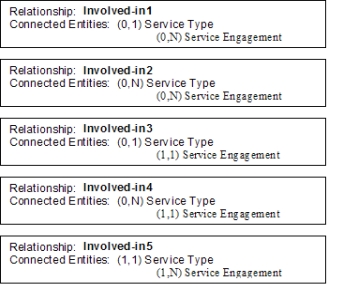
A) Involved-in1
B) Involved-in2
C) Involved-in3
D) Involved-in4
E) Involved-in5

A) Involved-in1
B) Involved-in2
C) Involved-in3
D) Involved-in4
E) Involved-in5

Unlock Deck
Unlock for access to all 55 flashcards in this deck.
Unlock Deck
k this deck
31
A bill of lading is a document that is usually prepared by the
A) Purchasing department
B) Manufacturing department
C) Billing department
D) Sales order department
E) Shipping department
A) Purchasing department
B) Manufacturing department
C) Billing department
D) Sales order department
E) Shipping department

Unlock Deck
Unlock for access to all 55 flashcards in this deck.
Unlock Deck
k this deck
32
The document accompanying a customer's payment on account is referred to as a(an)
A) Voucher
B) Remittance advice
C) Packing slip
D) Bill of lading
E) Invoice
A) Voucher
B) Remittance advice
C) Packing slip
D) Bill of lading
E) Invoice

Unlock Deck
Unlock for access to all 55 flashcards in this deck.
Unlock Deck
k this deck
33
A document indicating a reduction in the amount due from a customer because of returned goods or an allowance granted is called a:
A) Debit Memo
B) Sales Return and Allowances Journal
C) Credit Memo
D) Sales Invoice
E) Uncollectible Account Authorization Form
A) Debit Memo
B) Sales Return and Allowances Journal
C) Credit Memo
D) Sales Invoice
E) Uncollectible Account Authorization Form

Unlock Deck
Unlock for access to all 55 flashcards in this deck.
Unlock Deck
k this deck
34
Examine the following database tables. On June 19, 2010, Sale 06190800 was made to Anita Rockwell. Payment for this sale was received from Anita Rockwell on July 14, 2010. Upon receipt of the payment on July 14, 2010, into which of these tables was new data added? Assuming no mistakes were made, and all attributes of each table are shown. 
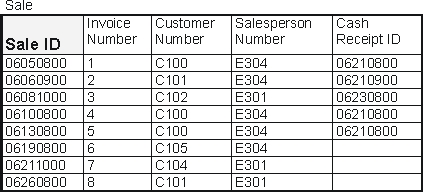
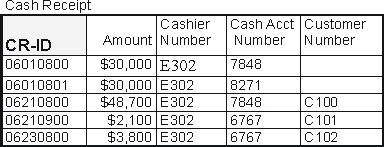
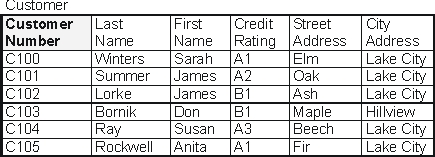

A) Cash Receipt and Sale
B) Cash and Cash Receipt
C) Cash Receipt, Sale, and Sale-Inventory-Line-Item
D) Cash, Cash Receipt, Sale, and Customer
E) Cash Receipt





A) Cash Receipt and Sale
B) Cash and Cash Receipt
C) Cash Receipt, Sale, and Sale-Inventory-Line-Item
D) Cash, Cash Receipt, Sale, and Customer
E) Cash Receipt

Unlock Deck
Unlock for access to all 55 flashcards in this deck.
Unlock Deck
k this deck
35
Examine the following tables from Carlisle Company's database. Calculate the total dollar amount of sales made by Jayne Joseph for the time period covered by this database. 
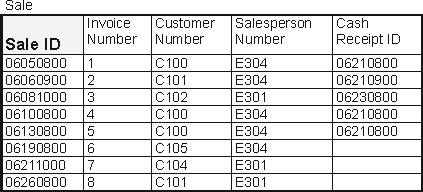
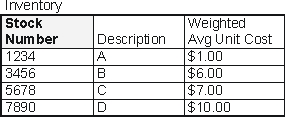

A) $ 18,000
B) $130,800
C) $ 3,800
D) $ 32,200
E) $ 10,400




A) $ 18,000
B) $130,800
C) $ 3,800
D) $ 32,200
E) $ 10,400

Unlock Deck
Unlock for access to all 55 flashcards in this deck.
Unlock Deck
k this deck
36
Examine the following tables from Carlisle Company's database. How many different types of inventory has Carlisle sold to James Warren? 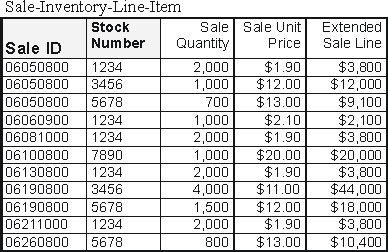
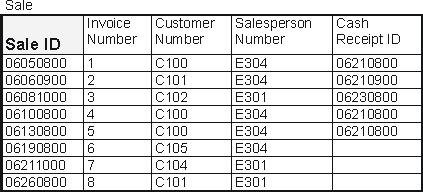
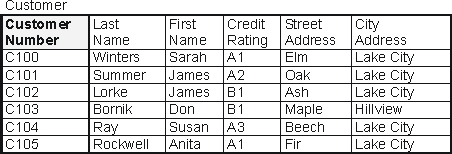
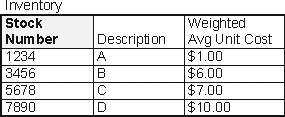
A) Two
B) Three
C) Four
D) Five
E) None of the above




A) Two
B) Three
C) Four
D) Five
E) None of the above

Unlock Deck
Unlock for access to all 55 flashcards in this deck.
Unlock Deck
k this deck
37
Examine the following tables from Carlisle Company's database. Calculate Carlisle Company's total Accounts Receivable balance. 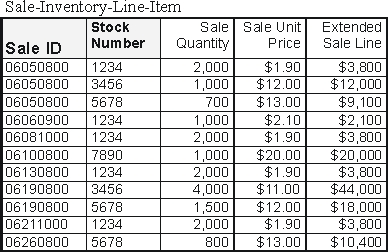
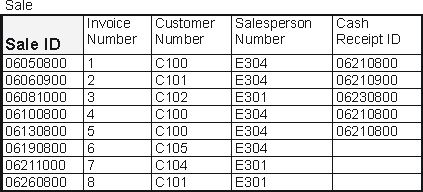

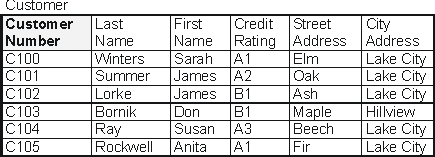

A) $ 76,200
B) $130,800
C) $ 54,600
D) $ 16,200
E) None of the above





A) $ 76,200
B) $130,800
C) $ 54,600
D) $ 16,200
E) None of the above

Unlock Deck
Unlock for access to all 55 flashcards in this deck.
Unlock Deck
k this deck
38
Examine the following tables from Carlisle Company's database. How much money does James Summer owe to Carlisle Company? 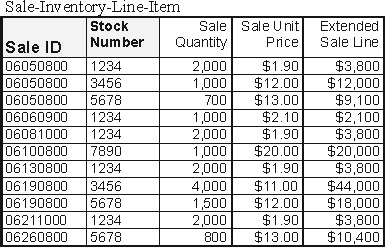
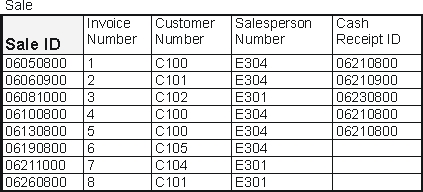
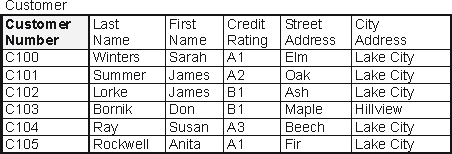
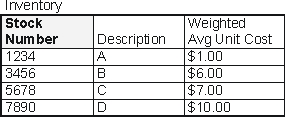
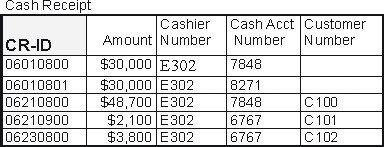
A) $10,400
B) $12,500
C) $10,800
D) None of the above





A) $10,400
B) $12,500
C) $10,800
D) None of the above

Unlock Deck
Unlock for access to all 55 flashcards in this deck.
Unlock Deck
k this deck
39
Which relationship should be the focus of a query that calculates the average number of days a company takes to collect its accounts receivable?
A) Stockflow
B) Participation
C) Duality
D) Reservation
E) Fulfillment
A) Stockflow
B) Participation
C) Duality
D) Reservation
E) Fulfillment

Unlock Deck
Unlock for access to all 55 flashcards in this deck.
Unlock Deck
k this deck
40
Which of the following information needs focuses on a Stockflow relationship in the Sales/Collection business process?
A) Calculation of the quantity of each inventory type that was increased by a specific sale return event
B) Creation of an open sale order file
C) Identification of the customer to whom a specific sale was made
D) Identification of which types of inventory were presented in a specific sales call
E) Identification of which marketing promotions have generated the largest quantity of sale orders
A) Calculation of the quantity of each inventory type that was increased by a specific sale return event
B) Creation of an open sale order file
C) Identification of the customer to whom a specific sale was made
D) Identification of which types of inventory were presented in a specific sales call
E) Identification of which marketing promotions have generated the largest quantity of sale orders

Unlock Deck
Unlock for access to all 55 flashcards in this deck.
Unlock Deck
k this deck
41
Examine the following value system level model for a manufacturing enterprise. What part(s) of this diagram encompass the sales/collection business process?
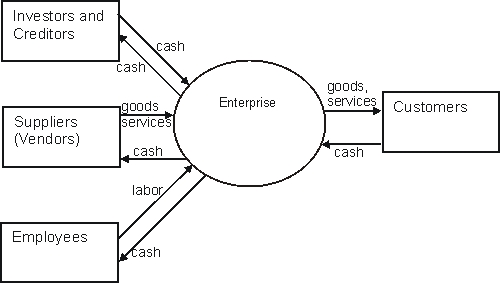


Unlock Deck
Unlock for access to all 55 flashcards in this deck.
Unlock Deck
k this deck
42
In a typical REA value chain for a service provider, what resource is used up in the revenue cycle, and what event uses up that resource?

Unlock Deck
Unlock for access to all 55 flashcards in this deck.
Unlock Deck
k this deck
43
Which departments are most likely to capture information regarding internally generated and externally generated instigation events in a typical revenue cycle?

Unlock Deck
Unlock for access to all 55 flashcards in this deck.
Unlock Deck
k this deck
44
How is a sale order similar to a customer order, and how is a sale order different from a customer order?

Unlock Deck
Unlock for access to all 55 flashcards in this deck.
Unlock Deck
k this deck
45
Fenzler Corporation shipped merchandise fob shipping point to Hayner Corporation on September 28, XXXX. Fenzler sent an invoice for the merchandise on October 3, XXXX, with payment terms 2/10,n/30. Hayner sent payment for the merchandise on November 1, XXXX. On which of these three dates should Fenzler recognize revenue for financial statement purposes?

Unlock Deck
Unlock for access to all 55 flashcards in this deck.
Unlock Deck
k this deck
46
List the resource, internal agent, and external agent typically associated with the Sale Order event in the revenue cycle.

Unlock Deck
Unlock for access to all 55 flashcards in this deck.
Unlock Deck
k this deck
47
What document is often used to capture information about enterprises' internally generated instigation events in their revenue cycles?

Unlock Deck
Unlock for access to all 55 flashcards in this deck.
Unlock Deck
k this deck
48
What is the normal order of events in a typical sales/collection process for a mail order firm that bills customers for goods upon shipment?

Unlock Deck
Unlock for access to all 55 flashcards in this deck.
Unlock Deck
k this deck
49
Which relationships in the sales/collection event usually include the Sale event?

Unlock Deck
Unlock for access to all 55 flashcards in this deck.
Unlock Deck
k this deck
50
Using the following tables, what are the first and last names of the customers who owe money to the enterprise?


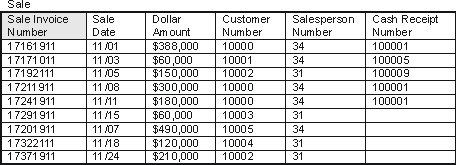




Unlock Deck
Unlock for access to all 55 flashcards in this deck.
Unlock Deck
k this deck
51
Given the following narrative description for Cheerful Cherubs Daycare Center:
a. Create a business process level REA model in either grammar or diagram format, for Cheerful Cherubs' sales/collection process. Be sure to include all relevant entities, relationships, attributes, and cardinalities (minimum and maximum).
b. Convert your business process level model into a set of minimal relational database tables. Be sure to identify primary and foreign keys in the relational tables.
Cheerful Cherubs (CC) is a daycare center that provides services to parents. (Note -- the parents are the customers, although the children are important to track, they are not the customers). CC is financed via debt. CC acquired the building in which it operates along with all the furniture and equipment. CC regularly purchases food and teaching supplies for its everyday use. CC provides day care for children from 3 weeks old to 5 years old. CC offers three types of service: Infant Care, Toddler Care, and Preschool. Each week of child care represents a separate "Service Engagement" and is documented via a service engagement invoice. Each invoice can include multiple types of service, since parents may have multiple children enrolled at different levels at CC. Types of service need to be input into the database before any child care is actually provided. CC's teachers are responsible for the child care services; at least one teacher is reflected on each invoice. Each child is assigned to a group; in rare circumstances, or when a child changes age categories, the child may be re-assigned to a different group. A group may consist of either 4 infants or 6 toddlers, or 10 preschool children. Each teacher is assigned to work with the same group each day, to provide consistency and stability for the children. If a teacher is ill or is on vacation, a substitute teacher cares for the absent teacher's group. A teacher may be re-assigned to a different group if circumstances dictate, and CC must keep track of all groups to which that teacher has been assigned. Teachers are entered into the database as soon as they are hired, before they have been assigned to a group and before they have provided any child care services. Children and their parents are entered into the database as soon as they come in for a school visit and express an interest in utilizing CC's services. If no age-appropriate group has an open slot for a child, the child is placed on a waiting list until an opening arises, or until enough additional children of that age are waiting (to warrant adding another teacher).
Parents are identified by their social security numbers. Since some children have parents that live at different addresses and have different work phone numbers, each parent is included separately in the database. Note: a child's legal guardian is considered a "parent" for purposes of CC. Children are assigned unique identification numbers, since they do not all have social security numbers. Parents are required to pay for services in advance. For example, on Friday of each week, parents must turn in written estimates of the number of hours for each specific day of the following week that they expect to leave their children, and they must pay for that number of hours. If parents need to leave children for more hours than estimated, they must pay for the extra hours along with their payment for the following week. Parents do not receive credit for unused hours, unless a child's illness requires the child to be absent for more than one day. In such cases, parents receive credit for each consecutive day of illness after the first day. For example, parents of a child scheduled for attendance Monday through Friday for 9 hours each day who misses Wednesday, Thursday and Friday due to illness, receive credit for 18 hours. Credit is deducted from the amount the parents pay for the next scheduled week.
Fees vary by type of service. Infant care costs $4.00 per hour, toddler care $3.50 per hour, and preschool $3.00 per hour. Each cash receipt (including those from loans and other sources) is processed by one of several CC cashiers. Cashiers are entered into the database as soon as they are hired, before they have processed any transactions. All parents associated with a child for whom payment is made for a service engagement invoice receive credit for that payment. For example, if Allison's mom pays for the child care for a particular week, the payment is considered to have come from both Allison's mom and from her dad. All cash received on a particular day is deposited into whichever one of CC's three bank accounts has the lowest balance; cash receipts cannot be recorded in the database without being associated with a valid bank account. Although bank accounts cannot be established without immediately depositing one or more cash receipts into them, CC must be able to enter the account information into the database before entering the related cash receipts.
In preparing your model and relational database tables, you must account for all of the following attributes. You may use the abbreviations (in parentheses) in your tables to save writing time. Do not add any attributes.
Parent Social Security Number (P-SSN)
Remittance Advice Number (RA#)
Service Engagement Invoice Number (Inv#)
Parent Name (P-Name)
Child Birthdate (C-BDay)
Cash Account Balance (Cash-Bal)
Service Type Code (S-Code)
Teacher Telephone Number (T-Ph#)
Child Name (C-Name)
Parent Home Phone Number (P-Home-Ph)
Parent Work Phone Number (P-Work-Ph)
Amount of Remittance advice applied to a particular invoice (RA-Amt-Applied)
Child Toilet Training Status (C-TT-Status)
Child ID Number (Child#)
Cashier Social Security Number (Csr-SSN)
Cash Account Number (Cash-Acct#)
Remittance Total Amount (RA-Amt)
Cashier Name (Csr-Name)
Teacher(s) providing care on a particular invoice (Teach-care)
Parent's Address (Par-Addr)
Cash Account Location (Cash-Acct-Loc)
Service Engagement Total Cost (SE-Tot$)
Date a Child was assigned to a particular Group (Date-Child-Assigned)
Service Type Name (ST-Name)
Number of Hours of Care for each type of service on a service engagement invoice (#Hours)
Address at which a particular Child lives (Child-Addr)
Service Type Hourly Rate (ST-Rate)
Service Engagement Line Item Cost (SE-Line$)
Teacher Social Security Number (T-SSN)
Group Number (Grp#)
Teacher Name (T-Name)
Number of Children in a Group (#Children)
Level of the Children in a Group, e.g. Infant, Toddler, Preschool (G-Level)
Date a Teacher was assigned to a particular Group (Date-Teach-Assigned)
Cashier Telephone Number (Csr-Ph#)
a. Create a business process level REA model in either grammar or diagram format, for Cheerful Cherubs' sales/collection process. Be sure to include all relevant entities, relationships, attributes, and cardinalities (minimum and maximum).
b. Convert your business process level model into a set of minimal relational database tables. Be sure to identify primary and foreign keys in the relational tables.
Cheerful Cherubs (CC) is a daycare center that provides services to parents. (Note -- the parents are the customers, although the children are important to track, they are not the customers). CC is financed via debt. CC acquired the building in which it operates along with all the furniture and equipment. CC regularly purchases food and teaching supplies for its everyday use. CC provides day care for children from 3 weeks old to 5 years old. CC offers three types of service: Infant Care, Toddler Care, and Preschool. Each week of child care represents a separate "Service Engagement" and is documented via a service engagement invoice. Each invoice can include multiple types of service, since parents may have multiple children enrolled at different levels at CC. Types of service need to be input into the database before any child care is actually provided. CC's teachers are responsible for the child care services; at least one teacher is reflected on each invoice. Each child is assigned to a group; in rare circumstances, or when a child changes age categories, the child may be re-assigned to a different group. A group may consist of either 4 infants or 6 toddlers, or 10 preschool children. Each teacher is assigned to work with the same group each day, to provide consistency and stability for the children. If a teacher is ill or is on vacation, a substitute teacher cares for the absent teacher's group. A teacher may be re-assigned to a different group if circumstances dictate, and CC must keep track of all groups to which that teacher has been assigned. Teachers are entered into the database as soon as they are hired, before they have been assigned to a group and before they have provided any child care services. Children and their parents are entered into the database as soon as they come in for a school visit and express an interest in utilizing CC's services. If no age-appropriate group has an open slot for a child, the child is placed on a waiting list until an opening arises, or until enough additional children of that age are waiting (to warrant adding another teacher).
Parents are identified by their social security numbers. Since some children have parents that live at different addresses and have different work phone numbers, each parent is included separately in the database. Note: a child's legal guardian is considered a "parent" for purposes of CC. Children are assigned unique identification numbers, since they do not all have social security numbers. Parents are required to pay for services in advance. For example, on Friday of each week, parents must turn in written estimates of the number of hours for each specific day of the following week that they expect to leave their children, and they must pay for that number of hours. If parents need to leave children for more hours than estimated, they must pay for the extra hours along with their payment for the following week. Parents do not receive credit for unused hours, unless a child's illness requires the child to be absent for more than one day. In such cases, parents receive credit for each consecutive day of illness after the first day. For example, parents of a child scheduled for attendance Monday through Friday for 9 hours each day who misses Wednesday, Thursday and Friday due to illness, receive credit for 18 hours. Credit is deducted from the amount the parents pay for the next scheduled week.
Fees vary by type of service. Infant care costs $4.00 per hour, toddler care $3.50 per hour, and preschool $3.00 per hour. Each cash receipt (including those from loans and other sources) is processed by one of several CC cashiers. Cashiers are entered into the database as soon as they are hired, before they have processed any transactions. All parents associated with a child for whom payment is made for a service engagement invoice receive credit for that payment. For example, if Allison's mom pays for the child care for a particular week, the payment is considered to have come from both Allison's mom and from her dad. All cash received on a particular day is deposited into whichever one of CC's three bank accounts has the lowest balance; cash receipts cannot be recorded in the database without being associated with a valid bank account. Although bank accounts cannot be established without immediately depositing one or more cash receipts into them, CC must be able to enter the account information into the database before entering the related cash receipts.
In preparing your model and relational database tables, you must account for all of the following attributes. You may use the abbreviations (in parentheses) in your tables to save writing time. Do not add any attributes.
Parent Social Security Number (P-SSN)
Remittance Advice Number (RA#)
Service Engagement Invoice Number (Inv#)
Parent Name (P-Name)
Child Birthdate (C-BDay)
Cash Account Balance (Cash-Bal)
Service Type Code (S-Code)
Teacher Telephone Number (T-Ph#)
Child Name (C-Name)
Parent Home Phone Number (P-Home-Ph)
Parent Work Phone Number (P-Work-Ph)
Amount of Remittance advice applied to a particular invoice (RA-Amt-Applied)
Child Toilet Training Status (C-TT-Status)
Child ID Number (Child#)
Cashier Social Security Number (Csr-SSN)
Cash Account Number (Cash-Acct#)
Remittance Total Amount (RA-Amt)
Cashier Name (Csr-Name)
Teacher(s) providing care on a particular invoice (Teach-care)
Parent's Address (Par-Addr)
Cash Account Location (Cash-Acct-Loc)
Service Engagement Total Cost (SE-Tot$)
Date a Child was assigned to a particular Group (Date-Child-Assigned)
Service Type Name (ST-Name)
Number of Hours of Care for each type of service on a service engagement invoice (#Hours)
Address at which a particular Child lives (Child-Addr)
Service Type Hourly Rate (ST-Rate)
Service Engagement Line Item Cost (SE-Line$)
Teacher Social Security Number (T-SSN)
Group Number (Grp#)
Teacher Name (T-Name)
Number of Children in a Group (#Children)
Level of the Children in a Group, e.g. Infant, Toddler, Preschool (G-Level)
Date a Teacher was assigned to a particular Group (Date-Teach-Assigned)
Cashier Telephone Number (Csr-Ph#)

Unlock Deck
Unlock for access to all 55 flashcards in this deck.
Unlock Deck
k this deck
52
Given the following narrative description for Do-it-all Enterprises:
a. Create a business process level REA model in either grammar or diagram format, for Do-it-all Enterprise's sales/collection process. Be sure to include all relevant entities, relationships, attributes, and cardinalities (minimum and maximum).
b. Convert your business process level model into a set of minimal relational database tables. Be sure to identify primary and foreign keys in the relational tables.
Do-it-all Enterprises is an organization that provides a wide variety of service offerings for clients. Service types available include bookkeeping, computer installation, computer repair, software installation, taxes, advertising, market surveys, etc. Each service engagement may involve multiple types of service and may include multiple employees. Each type of service has a standard hourly billing rate and can not be entered into the database unless at least one of Do-it-all's employees is capable of performing that type of service. Employees are trained to perform multiple types of services and can work on multiple service engagements. Employees earn a contracted annual salary based on their credentials, regardless of what services they actually end up performing. Clients are required to pay for a given service engagement in full (with just one check) within two weeks of the completion date. It is possible for a client to pay for more than one service engagement with just one check, so Do-it-all must allow for that possibility in its database. Each client payment is processed by exactly one of Do-it-all's three cashiers and is deposited in full into one of Do-it-all's two bank accounts. Cash receipts cannot be recorded in the database without being associated with a valid bank account. Although bank accounts cannot be established without immediately depositing one or more cash receipts into them, CC must be able to enter the account information into the database before entering the related cash receipts. Employees and clients are entered into the database before any transactions involving them occur.
The following attributes must be accounted for in your model.
Service-type-ID-number
Name-of-Client
Invoice-number-for-service-engagement
Dollar-amount-of-cash-receipt
Cash-receipt-ID-number
Location-of-cash-account
Cash-account-ID-number
Client-accounts-receivable-balance
Client-ID-number
Employee-phone-number
Employee-ID-number
Highest-degree-of-an-employee
Employee-annual-salary-amount
Standard-hourly-billing-rate-for-a-service-type
Total-charge-for-service-engagement
Number-of-hours-of-each-service-type-performed-on-each-service-engagement
a. Create a business process level REA model in either grammar or diagram format, for Do-it-all Enterprise's sales/collection process. Be sure to include all relevant entities, relationships, attributes, and cardinalities (minimum and maximum).
b. Convert your business process level model into a set of minimal relational database tables. Be sure to identify primary and foreign keys in the relational tables.
Do-it-all Enterprises is an organization that provides a wide variety of service offerings for clients. Service types available include bookkeeping, computer installation, computer repair, software installation, taxes, advertising, market surveys, etc. Each service engagement may involve multiple types of service and may include multiple employees. Each type of service has a standard hourly billing rate and can not be entered into the database unless at least one of Do-it-all's employees is capable of performing that type of service. Employees are trained to perform multiple types of services and can work on multiple service engagements. Employees earn a contracted annual salary based on their credentials, regardless of what services they actually end up performing. Clients are required to pay for a given service engagement in full (with just one check) within two weeks of the completion date. It is possible for a client to pay for more than one service engagement with just one check, so Do-it-all must allow for that possibility in its database. Each client payment is processed by exactly one of Do-it-all's three cashiers and is deposited in full into one of Do-it-all's two bank accounts. Cash receipts cannot be recorded in the database without being associated with a valid bank account. Although bank accounts cannot be established without immediately depositing one or more cash receipts into them, CC must be able to enter the account information into the database before entering the related cash receipts. Employees and clients are entered into the database before any transactions involving them occur.
The following attributes must be accounted for in your model.
Service-type-ID-number
Name-of-Client
Invoice-number-for-service-engagement
Dollar-amount-of-cash-receipt
Cash-receipt-ID-number
Location-of-cash-account
Cash-account-ID-number
Client-accounts-receivable-balance
Client-ID-number
Employee-phone-number
Employee-ID-number
Highest-degree-of-an-employee
Employee-annual-salary-amount
Standard-hourly-billing-rate-for-a-service-type
Total-charge-for-service-engagement
Number-of-hours-of-each-service-type-performed-on-each-service-engagement

Unlock Deck
Unlock for access to all 55 flashcards in this deck.
Unlock Deck
k this deck
53
Create a "generic" REA business process level model (without cardinalities) in either grammar or diagram format to represent the sales/collection business process for a company that sells merchandise via mail order. Your model should encompass the entire sales/collection process, from the marketing of merchandise to the collection of cash, and allow for the possibility of sale returns (for account credit only).

Unlock Deck
Unlock for access to all 55 flashcards in this deck.
Unlock Deck
k this deck
54
Given the following narrative description for Super-Duper Shuttle Service Company:
a. Create a business process level REA model in either grammar or diagram format, for Super-Duper Shuttle Service Company's sales/collection process. Be sure to include all relevant entities, relationships, attributes, and cardinalities (minimum and maximum).
b. Convert your business process level model into a set of minimal relational database tables. Be sure to identify primary and foreign keys in the relational tables.
The Super-Duper Shuttle Service Company (SDSSC) makes money by providing transportation to customers in exchange for money. A typical day involves a shuttle van driving around the city, mostly between the airport and various locations. For example, a van may start the day by picking up three passengers from a local hotel and dropping them off at the airport. Two of these passengers are a husband and wife traveling together and the wife pays for both of them. The other person just happened to be staying at the same hotel and had also called SDSSC for a ride to the airport. This one trip to the airport thus consists of two service engagements. At the airport, six more passengers get on. Three of them are co-workers who need to go to a local manufacturing plant and whose corporation has an account with SDSSC. One passenger needs to go to Hotel A and the other two passengers need to go to Hotel B. Customers may either be individuals or corporations. SDSSC owns many vans, each of which holds up to six passengers with luggage. A service engagement usually involves just one van, but sometimes will include more than one van. For example, if a corporate customer is sponsoring a training seminar, it might call SDSSC and request several vans for one engagement to transport a large group of employees to another location. The drivers of the SDSSC vans are responsible for providing the transportation services to all customers and they process the cash receipts from individual customers (who are required to pay the driver when they enter the van). Corporate customers pay for all transportation services contracted in a given month on the 15th day of the following month - they NEVER make partial payments. Cash received from corporate customers is processed by one of SDSSC's five cashiers. All cash receipts for a particular day are deposited into one of several bank accounts owned by SDSSC; the account into which they are deposited rotates from day to day. Cash receipts cannot be recorded in the database without being associated with a valid bank account. Although bank accounts cannot be established without immediately depositing one or more cash receipts into them, CC must be able to enter the account information into the database before entering the related cash receipts. SDSSC has specifically requested to keep cashiers and drivers in separate tables rather than combining them into one employee table. SDSSC has also requested to be able to input data about vans, employees and corporate customers before any transactions involving them actually take place.
The following attributes must be accounted for in your model.
Driver ID
Dollar amount of a service engagement
Customer number
Date of most recent oil change for a van
Cash receipt amount
Driver name
Cash account number
Cashier ID
Origination of a service engagement
Customer name
Van vehicle identification number
Cashier telephone number
Date a van was acquired
Type of customer (individual/corporate)
Customer address
Number of points on a driver's license
Customer telephone number
Cash receipt number
Cash receipt date
Destination for a service engagement
Service engagement invoice number
Cashier name
Cashier address
Driver address
Driver telephone number
Cashier's fidelity bond rating
Date of a service engagement
Mileage at most recent oil change for a van
Driver's license number
Cash account balance
Type of a cash account (e.g. checking, savings)
Location of a cash account
Starting time of a service engagement
Ending time of a service engagement
Customer account receivable balance
a. Create a business process level REA model in either grammar or diagram format, for Super-Duper Shuttle Service Company's sales/collection process. Be sure to include all relevant entities, relationships, attributes, and cardinalities (minimum and maximum).
b. Convert your business process level model into a set of minimal relational database tables. Be sure to identify primary and foreign keys in the relational tables.
The Super-Duper Shuttle Service Company (SDSSC) makes money by providing transportation to customers in exchange for money. A typical day involves a shuttle van driving around the city, mostly between the airport and various locations. For example, a van may start the day by picking up three passengers from a local hotel and dropping them off at the airport. Two of these passengers are a husband and wife traveling together and the wife pays for both of them. The other person just happened to be staying at the same hotel and had also called SDSSC for a ride to the airport. This one trip to the airport thus consists of two service engagements. At the airport, six more passengers get on. Three of them are co-workers who need to go to a local manufacturing plant and whose corporation has an account with SDSSC. One passenger needs to go to Hotel A and the other two passengers need to go to Hotel B. Customers may either be individuals or corporations. SDSSC owns many vans, each of which holds up to six passengers with luggage. A service engagement usually involves just one van, but sometimes will include more than one van. For example, if a corporate customer is sponsoring a training seminar, it might call SDSSC and request several vans for one engagement to transport a large group of employees to another location. The drivers of the SDSSC vans are responsible for providing the transportation services to all customers and they process the cash receipts from individual customers (who are required to pay the driver when they enter the van). Corporate customers pay for all transportation services contracted in a given month on the 15th day of the following month - they NEVER make partial payments. Cash received from corporate customers is processed by one of SDSSC's five cashiers. All cash receipts for a particular day are deposited into one of several bank accounts owned by SDSSC; the account into which they are deposited rotates from day to day. Cash receipts cannot be recorded in the database without being associated with a valid bank account. Although bank accounts cannot be established without immediately depositing one or more cash receipts into them, CC must be able to enter the account information into the database before entering the related cash receipts. SDSSC has specifically requested to keep cashiers and drivers in separate tables rather than combining them into one employee table. SDSSC has also requested to be able to input data about vans, employees and corporate customers before any transactions involving them actually take place.
The following attributes must be accounted for in your model.
Driver ID
Dollar amount of a service engagement
Customer number
Date of most recent oil change for a van
Cash receipt amount
Driver name
Cash account number
Cashier ID
Origination of a service engagement
Customer name
Van vehicle identification number
Cashier telephone number
Date a van was acquired
Type of customer (individual/corporate)
Customer address
Number of points on a driver's license
Customer telephone number
Cash receipt number
Cash receipt date
Destination for a service engagement
Service engagement invoice number
Cashier name
Cashier address
Driver address
Driver telephone number
Cashier's fidelity bond rating
Date of a service engagement
Mileage at most recent oil change for a van
Driver's license number
Cash account balance
Type of a cash account (e.g. checking, savings)
Location of a cash account
Starting time of a service engagement
Ending time of a service engagement
Customer account receivable balance

Unlock Deck
Unlock for access to all 55 flashcards in this deck.
Unlock Deck
k this deck
55
List the similarities and differences in the interfaces between the sales/collection process and other business processes in typical REA value chain models for manufacturers, wholesale distributors, and service providers.

Unlock Deck
Unlock for access to all 55 flashcards in this deck.
Unlock Deck
k this deck



